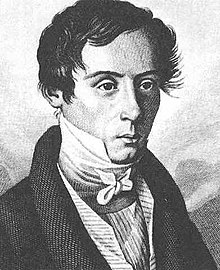
Reflection and refraction are two methods by which astronomers gaze at the stars. Reflection was pioneered by Newton. It uses a concave mirror to focus the collected light. Refraction was pioneered by Galileo. It uses a series of in line lenses to do the same thing. Above is a picture of Augustin-Jean Fresnel. He developed diffraction to achieve the same results. Diffraction uses a series of concentric rings that alternate between opaque and clear. The idea is to scatter and spread the light waves in a manner whereby they end up reinforcing themselves and cause an image by the reinforced waves. Unfortunately, logistical issues posed by the Earth's atmosphere would end up requiring a several kilometer long diffraction telescope, so the Fresnel telescopes were never developed. The Economist has a great article whereby they suggest using a diffracting telescope in space to look for life in another solar system, where the Earth's atmosphere no longer is an impediment. If the Fresnel telescope finds waves equating to oxygen in another planet's atmosphere, then we have likely found ET. Oxygen is a very reactive element that is only present in abundance here on Earth because of the constant biologic processes producing it.
No comments:
Post a Comment